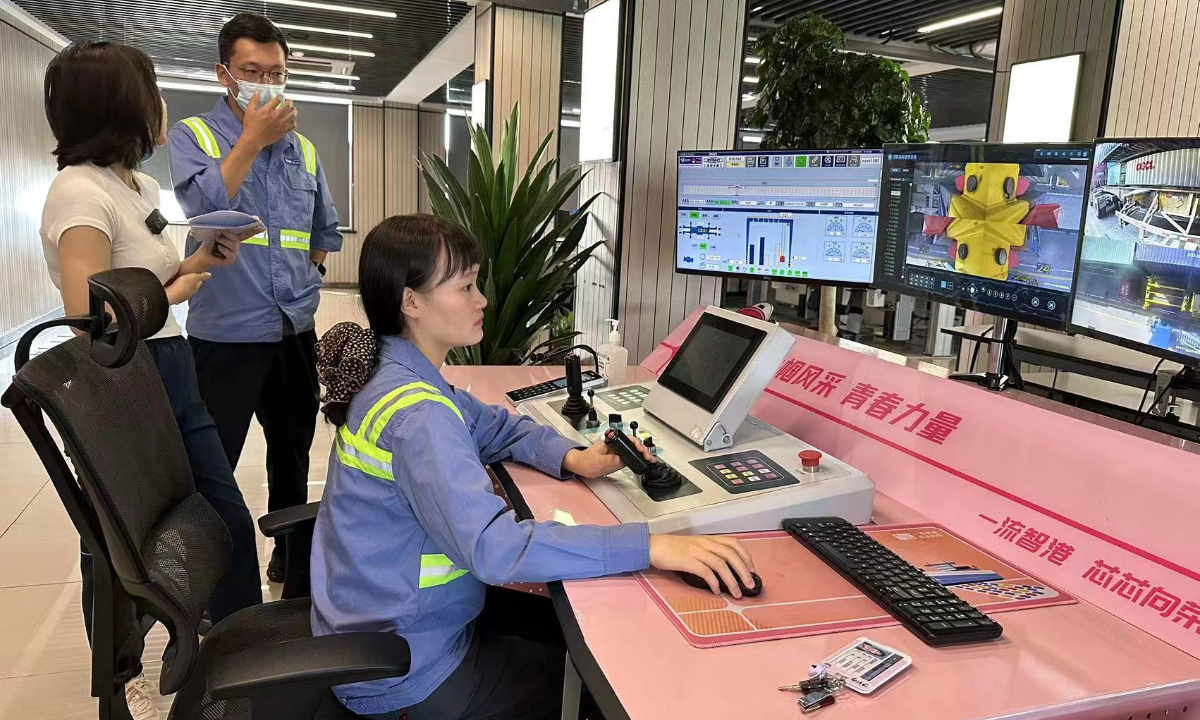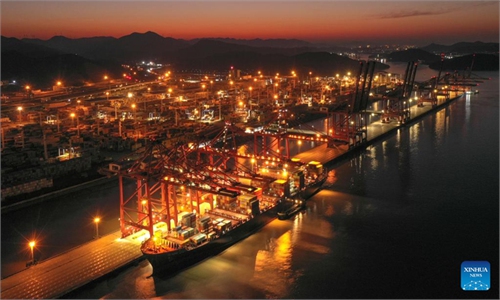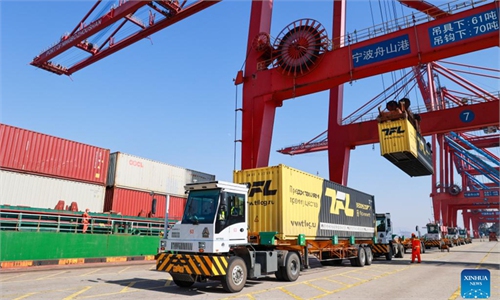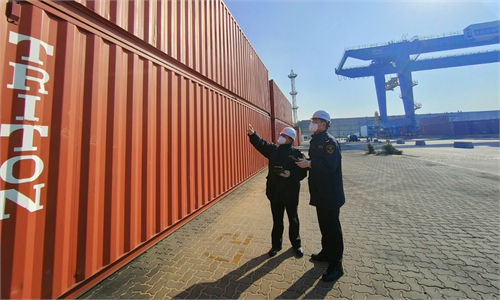E. China’s Ningbo-Zhoushan Port, world’s biggest, eyes higher trade despite ‘decoupling’ push
Ningbo-Zhoushan eyes higher commerce despite ‘decoupling’ push

Workers at the Ningbo-Zhoushan Port in East China’s Zhejiang Province on June 26, 2023 Photo: Zhu Malie/GT
The sun shone brightly in the clear, blue sky right before noon at the Meishan Port Area of the Ningbo-Zhoushan Port in Ningbo, East China’s Zhejiang Province. Several massive, red tower cranes were simultaneously loading and unloading containers from a huge cargo vessel belonging to French shipping giant CMA CGM.
A stream of trucks lined up to pick up the containers. Behind the cranes, a mountain of containers sat quietly. But as the day-shift workers finished their day around 4 pm and left on buses, the rain started to fall.
At this time of the year, the weather in Ningbo is elusive – it could be all sunshine one minute and rain the next. “Plum rain” season, as locals name it, comes around June and July each year. It refers to the raining season in China’s eastern coastal provinces where plums ripen.
If one thing can aptly sum up the global trade situation at the moment, plum rain season could very well be it.
While China’s trade with the world continues to grow -- a much needed sunshine for the global economy shrouded in a stubborn downturn, some in the West are pouring cold water on what has been mutually beneficial trade between China and the world. They first wanted to “decouple,” and after it did not bode well for their own economies, now they want to “de-risk.” The same medicine stuffed in a different bottle, as many in China call it.
Reliable barometer
The question is how this is affecting China’s foreign trade with the rest of the world. To that end, operations at the Ningbo-Zhoushan Port can offer some reliable clues. This is the largest port in the world in terms of the tonnage of goods it handles each year.
In 2022, 1.26 billion tons of goods went through the port, ranking first globally for the 14th consecutive year. In terms of the number of containers, the port ranks third globally, with 33.35 million in 2022. It has long been considered a window into and barometer for China’s foreign trade as well as the global commerce.
During a recent trip to the port, as part of a 24-hour livestream session by huanqiu.com that aims to show how the port sends Chinese goods to around the world, a clear picture emerged that is quite different from the rather grim outlook painted by many Western media. Yes, there is a sense of uncertainty among many at the port, but the overwhelming feeling is that win-win trade between China and other countries around the world won’t stop just because some politicians in the West decide that trade with the world’s largest trading nation is a “risk.”
“We are seeing a steady growth both in terms of throughput at the port and Ningbo’s foreign trade,” Li Guanding, deputy mayor of Ningbo, told the Global Times, as he passionately and proudly talked about the city’s enormous trade industry, which lifted Ningbo to become China’s 6th city with a trade volume exceeding 1 trillion yuan, and its world-class port. “It really shows the resilience of our foreign trade.”
According to Li, the Ningbo-Zhoushan Port handled about 562 million tons of goods in the first five month of 2023, while Ningbo’s import and export reached 514.2 billion yuan, both achieving “stable growth.” Among the major exported items highlighted by Li are electric vehicles, whose exports surged by 96 percent year-on-year. “This is a giant leap in terms of the quality of trade,” he said.
Meanwhile, Ningbo’s trade with ASEAN, the Middle East, Russia, Latin America and other emerging market economies saw big increases since the beginning of the year.
Notably, China’s trade with Russia and Mexico surged 100 percent and 46 percent year-on-year respectively. Moreover, trade with countries and regions along the Belt and Road Initiative (BRI) are set to accelerate, as shipping routes are increasing. Of the port’s more than 300 shipping lines, over 120 are linked with BRI countries.
That is largely in line with the overall picture of China’s foreign trade in the first five months. China's foreign trade grew 4.7 percent year-on-year in the first five months of the year, with exports growing 8.1 percent year-on-year, while imports grew by 0.5 percent.
Steady expansion
While growth in both exports and imports and Ningbo-Zhoushan Port’s throughput witnessed a slowdown in May, prompting foreign media hype and grim predictions of China’s economic recovery, officials and analysts stress that the trade figures remain stable which show the resilience of China’s trade, despite weak demand globally and rising trade barriers.
As if the global economic downturn wasn’t bad enough, many US politicians and a few in the EU are continuing to push for a trade “decoupling” from China, even though they have recently changed their rhetoric to “de-risking.”
Wen Jianping, who is in charge of operations at the Zhongzhai wharf of the Chuanshan Port Area, said that “what we are seeing so far is steady growth,” noting stable growth in throughput in the first half of 2023. As of Monday, throughput exceeded 60 million tons, while the amount of iron ore unloaded reached 32.6 million tons, with both achieving the targets in advance.
Wen said that the Zhongzhai warf, which handles iron ore, coal and other minerals, aims to keep annual throughput at above 120 million tons, a milestone reached in 2022 that has become a long-term goal. To that end, the port is expanding operations. On a raining afternoon on Tuesday, even as four cranes simultaneously unloaded imported coal from Russia, construction machines roared nearby, busy building the second phase of Zhongzhai Ore Terminal.
Expanding operations and improving efficiency is a main theme of the entire Ningbo-Zhoushan Port. Apart from construction sites, cutting-edge technologies such as 5G and artificial intelligence are adopted in many aspects of port operations.
At the Meishan Port Area, dozens of 5G-powered driverless trucks were hard to miss. Remotely controlled cranes were also working seamlessly. These really look futuristic. All the expansion and upgrading are looking toward a future of continued trade between China and the rest of the world despite the political talks of “decoupling” or “de-risking.”
In the end, all the efforts are taken to ensure the world’s biggest port will continue to operate efficiently regardless of sunshine or rain during the plum season in Ningbo.




